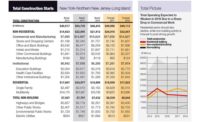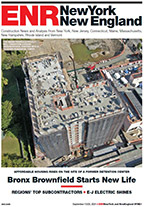From Hudson Yards' long-awaited $843-million first building to several $150-million-plus towers, the tristate region's ranking of the top 25 projects to break ground last year show that building tall and building big is back. The residential sector, in particular, dominates tower construction on the list, with most buildings advertised as luxury apartments and condos in prime New York City locations.
Despite such gains, the aggregated total contract value of the largest 25 starts is about $7.9 billion, even with the prior year's level, which was down from 2010's $8.8 billion. None of these starts, however, came close to the $18.6 billion in new construction represented in the 2009 ranking.
The situation is no surprise to industry executives in the tristate region who say that construction activity seems to be only slowly recovering from the recession, and that too many uncertainties remain for a complete ramp up to the levels reached from 2003 to 2008.
Work had been "clicking on all cylinders" during that five-year period with every sector showing strong growth, says Richard Anderson, president at New York Building Congress (NYBC), New York. He says that such growth had not happened in the New York market for decades and may not happen again for many decades to come. The five years before the recession were "an incredibly productive and somewhat inflationary period," he adds. "It's really hard to imagine that we will see a quick return to that kind of a boom."
Instead, it is likely that work will move along as it more typically has, with some sectors booming as others lag, Anderson says. The New York City residential market has been firmly on the booming side since mid-2011, he adds. Given market conditions, it is no surprise that some of the projects that restarted construction in Manhattan last year—including the $500-million 50 United Nations Plaza (No. 3) and the $384-million 56 Leonard Street tower (No. 7)—are high-end residential developments.
Gerald Bianco, Lend Lease project executive and senior vice president, says he believes the residential sector was the hardest hit during the recession. "We were really in a boom before, and then the bottom fell out," he says. Lend Lease is the construction manager (CM) at 50 U.N. Plaza and 400 Park Avenue South apartment and condo tower (No. 17). The firm was also brought on board as CM in 2011 at 56 Leonard Street to pick up where the stalled project left off.
"The condo market dried up, but rentals that were already under way pretty much continued through the downturn," Bianco says. The condo market appears to be returning now, however, driven largely by foreign investors seeking to buy units in Manhattan's luxury towers, he says. Demand is up for complex designs and features such as sloping walls, high slab heights and large ceiling-to-floor views. "Not many of our buildings just go straight up anymore," and the complexity of design seems to be indicative of sellers seeking higher prices, he adds.
For the tristate region, the rise in residential starts also reflects the gains in the national market as shown in McGraw-Hill Construction's (MHC) latest data. Nationally, single- and multifamily housing rose 27% year-over-year, to nearly $12 billion in January, the data show. "Multifamily housing can be volatile on a month-to-month basis, and single-family housing is considerably stronger than the same time a year ago," Robert Murray, MHC vice president of economic affairs, said last month in a statement on the starts. "On balance, the housing recovery should be able to continue during 2013, even with a lackluster performance by the overall economy."
There is not as much activity on the commercial side, although momentum appears to be gaining speed in and around New York City, Bianco says.
That is backed up by the latest statistics from NYBC, which recently released a report analyzing MHC data on 2008-2012 New York City starts, including new projects as well as alterations and renovations. "While office buildings were conspicuously absent from the top projects list, the sector is off to a very promising start [in] 2013," Anderson said in a statement on the report.
He cites several new mega-commercial developments that, though they took years to start, bode well for industry. These include Related Cos. and Oxford Properties Group's 1.7-million-sq-ft office-retail tower at Hudson Yards (No. 1), which broke ground last December and is part of a larger $15-billion multiyear development plan [story, p. 20]. He also cites Brookfield Office Properties' $4.5-billion Manhattan West project that includes one apartment and two office towers. Brookfield broke ground in January on a rail platform over which the 5-million-sq-ft project will be built.
In the tristate's nonresidential building sector, the institutional market is not well represented in the ranking, although it has been strong for the region throughout the recession. Executives say that this is not a sign that the institutional market is waning, however. In higher education, many of the region's major universities with project plans are gearing up for big projects, so work is on the way, they add.
In fact, some higher education projects did start last year, but their individual contract values were not higher than the University of Rochester Medical Center's $145-million Golisano Children's Hospital (No. 25), which had the lowest contract value in the ranking.
Golisano is the university's largest capital project ever. Crews are currently working on site utilities and foundations on the eight-floor, 245,000-sq-ft hospital, says Josh Reinhard, senior project manager at LeChase Construction Services, Rochester, N.Y., the CM on the three-year project.
Health care has been a fairly strong market, but even it was affected by uncertainties in the last 18 months, says Rich Steimel, New York-based Tishman Construction Co. senior vice president and health care project executive. These included the presidential election as well as health care law and insurance reforms, all of which resulted in some providers taking a wait-and-see approach on projects.
"The uncertainty made 2012 a little bit of a slower startup year," Steimel says. But the sector is moving on with more work expected this year and next, particularly in ambulatory care facilities, he adds.
Health care is a major growth market in Connecticut, which has no projects in the ranking. Even so, numerous hospitals and medical institutions statewide have building programs planned or under way, including the state's much anticipated Bioscience Connecticut project, says John Butts, Associated General Contractors of Connecticut executive director. The initiative is projected to provide an average of 3,000 construction jobs annually through 2018. Work began in January on the $191-million Jackson Laboratory for Genomic Medicine, the first of many structures planned under the initiative.
Connecticut has some work in this and other nonresidential building sectors, Butts says. But "we still don't know what is going on in the private sector. We are seeing tower cranes in Boston and New York City and nothing in between," he adds.
Meanwhile, transportation and other nonbuilding sectors made a strong showing in the ranking, with several new contracts that are part of long-term projects. These include New York's Second Avenue Subway (SAS) (Nos. 8 and 14) and Water Tunnel No. 3 (No. 13) [story, p. 14] as well as New Jersey's Susquehanna-Roseland Power line (No. 2).
Eight of the 10 contract packages have been awarded so far on the $4.51-billion SAS project, says Richard Paupst, project manager of Transit Rail at AECOM, which has teamed with Arup as the SAS engineer. One bid—for the 72nd Street Station's architectural, finishes and mechanical, electrical and plumbing work—had been accepted but not yet awarded at press time. The last bid—for the same type of work at the 86th Street Station—"is on the street now and we're expecting bids shortly," he says.
As with any Manhattan project, the SAS is challenging as contractors try to navigate around people and vehicle traffic, Paupst says. Nevertheless, he adds, it is on track to be completed in December 2016.
Keeping the Flow Under Manhattan
With the Manhattan portion of New York City’s third water tunnel nearing completion, the city’s Dept. of Design and Construction (DDC) began two projects last year to connect the tunnel to the rest of Manhattan’s distribution system. The Trunk Water Main Connections Tunnel Shaft projects involve installing 3.5 miles of steel trunk water mains.
DDC, which is performing the work on behalf of NYC Dept. of Environmental Protection (DEP), is building 10 of the 11 shaft connections citywide; DEP is connecting one vertical shaft.
Some of the water mains are as large as 48 in. in diameter, says Tom Foley, DDC assistant commissioner. The first contract, for $270 million, started in April 2012 and is set for completion in April 2017. The second, for $27 million, began in December. Both projects have so far created 250 jobs, Foley says. DDC is preparing to start up other such projects later this year, he adds.
DDC has nearly $1 billion of Manhattan infrastructure work in the pipeline planned for the next five years and several billion dollars more in the outer boroughs, Foley says.






